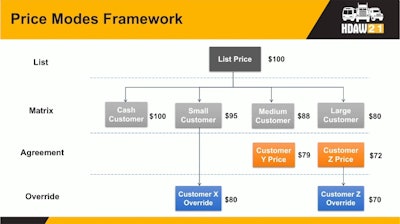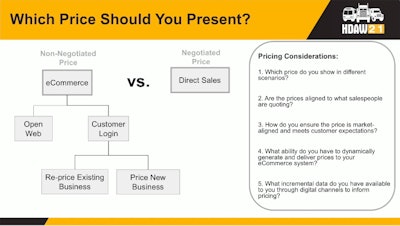
Setting prices in the truck parts industry has never been easy.
In a market where customer demographics, order volumes and purchasing channels all impact retail price, aftermarket distributors must be masters of the pricing matrix. Distributors must devise (and constantly revise) complex pricing structures that entice new customers and sustain existing customer relationships while also maintaining healthy product margins and long-term profits.
It’s a constant challenge. A task that can be learned and even mastered but is never truly complete. And it’s only getting harder.
To have a functional, flexible and comprehensive pricing matrix in today’s aftermarket, distributors must also be masters of their digital footprints. Today’s truck parts customers may still prefer in-store sales to online purchasing on the whole, but there’s no guarantee that tomorrow’s buyers will feel the same. E-commerce sales in the United States rose by 44 percent last year — the largest single-year shift this millennium, reported Digital Commerce 360 — and acceptance of digital commerce has never been higher.
In the aftermarket, this growing customer shift means distributors must be quickly adapting their pricing matrices to account for e-engagement.
During a session on digital selling at virtual Heavy Duty Aftermarket Week (HDAW) in January, Zilliant’s Chief Marketing Officer Lindsay Duran broke down exactly why careful pricing is a requirement for aftermarket e-commerce, and why one-size-fits-all pricing used by the nation’s largest e-tailers doesn’t work for online wholesale distribution sales.
Duran says the most important thing for distributors to remember when building a digital sales presence is to keep one’s focus on customers and their ideal purchasing experience. She says distributors do a great job developing highly informed, capable sales teams to support their customers in the field and says when customers interact with a distributor online they expect a similar experience.
RELATED: Understanding the ‘science of B2B sales’
With pricing, specifically, she says that translates to an expectation of consistency, transparency and attentiveness. In the same way customers expect similar pricing from store to store, they also expect pricing stability when they go online. She says pricing matrices developed for brick-and-mortar sales should be leveraged across e-commerce platforms, particularly ordering portals and behind login pages where existing customers will spend most of their time.
Distributors must “make sure pricing relationships between and within online and offline channels are aligned,” says Duran, adding when customers get online, the prices they see always should be tailored to them. She acknowledges this can be a challenge for distributors who give their salespeople the autonomy to set prices for their accounts, but that doesn’t mean those businesses can’t have success selling parts online.
 An example of a typical pricing matrix seen in wholesale distributor operations, presented by Zilliant's Lindsay Duran during virtual HDAW in January.
An example of a typical pricing matrix seen in wholesale distributor operations, presented by Zilliant's Lindsay Duran during virtual HDAW in January.
Duran advises distributors in those positions to bring their salespeople into their online pricing development, working together to put prices online that will correspond with what those salespeople would quote in the market. Additionally, Duran says whenever a price is changed that adjustment should immediately be communicated throughout the business to ensure customers continue to receive consistent price messaging.
A commitment to e-commerce also may require a recalibration of how salespeople are compensated. Duran says sales associates who earn on commission are unlikely to support an employer’s e-commerce efforts if they perceive it will negatively impact their earnings. That’s why she encourages distributors to maintain commissions for online sales or alter commission percentages so sales associates earn more on complicated consultative sales to offset any potential earnings they may lose to online stock orders and simple purchases.
There’s no better marketing team for a fledging e-commerce website than a committed and supportive sales force, Duran says, though “you have to make sure you’re communicating with them about why a change is necessary and how it can be good for them.”
Fortunately, e-commerce platforms exist for aftermarket distributors that can enable multi-faceted, dynamic pricing.
PhaseZero, which has partnerships and integrations with VIPAR Heavy Duty and Karmak, among other aftermarket operators, built its e-commerce platform to interface directly with distributor business systems. Whenever a distributor alters a price within its DMS, that update is immediately pushed to its e-commerce site, says Founder and CEO Ram ChandraSekar. According to Chandra, this feature is important because it ensures distributors are never placed in a position where they are unable to show consistent, optimal pricing to any customer.
“We have nanosecond real-time integration with any business system we integrate with. We don’t set prices ourselves,” he says. “We give that power to the business.”
And when selling online, distributors should be open to pricing changes. Thanks to cookies and other digital breadcrumbs, advanced website engagement data and analytics provide online sellers far more information about customer buying habits and decision making than could possibly be acquired in a conventional retail setting. A brick-and-mortar distributor can use tried-and-true formulas to determine what they believe is an ideal price for a part. But once they put that part on a shelf, there’s no way to gain insight into how it is priced unless customers actively discuss it.
That’s not the case online. With website analytics, online distributors can see exactly how many customers engage with a part at a certain price, as well as how many follow through and buy the part or abandon the purchase. This enables distributors to proactively monitor their inventory in real time to identify parts that may be priced incorrectly and need adjustment.
“The competitive nature of the market drives pricing,” Chandra says. “Our pricing approach is configurable and customizable for specific customers, channels, etc.”
That’s how FinditParts manages its inventory of more than 10 million products, says David Seewack, founder and CEO.
“We price competitive to the market. We never want to be the price leader,” says Seewack. “We use intelligent pricing models that enable us to change price at any time based on transaction activity … It’s kind of like what you see with airlines. Some days you will see one price and the next day the price will be slightly different.”
Admittedly, FinditParts’ extreme pricing flexibility isn’t something that can be easily replicated by a brick-and-mortar store. Asking a salesperson to remember a few new prices each week might be doable but asking them to accept new prices on potentially thousands of products each day would be impossible.
But the experts also note more often than not, if a distributor’s in-store price is competitive in its market and is driving steady turns, chances are it should be equally suitable online. Especially within order portals where all users are existing customers already familiar with a distributor’s pricing structure.
Seewack says FinditParts’ customer base has expanded substantially since its inception but adds most customers who use the site still also continue to do business with their local stores. He says FinditParts provides them a resource to supplement their purchasing but acknowledges the site still can’t replace the distributor down the block who can deliver a part in an hour or less.
“Our customer journey basically starts when a customer can’t find a part locally,” he says. “Once they get more comfortable online they might buy more, but they don’t come to us usually until they’ve exhausted their local options.”
That means local suppliers must be ready to serve any way they can. Distributors should look at e-commerce not as a burden, but as another arm to their customer-facing sales team, Duran says, available 24/7 with the products and information customers are searching for and need.
“Don’t manage e-commerce and e-commerce pricing in a vacuum,” she says. “Everything you do needs to be integrated and working together.”
Chandra agrees, noting if there’s one retail trend the last year has confirmed, it’s that the public’s acceptance of online purchasing is only going to increase.
“You have to understand that the competitive landscape is changing. You are not just competing against the guy across the street anymore,” he says. “Your customer is king. You have to serve them in the way they are expecting.”
 Prices displayed in a digital setting by wholesale distributors should be dynamic and customized to the customer who is shopping, says Zilliant's Lindsay Duran.
Prices displayed in a digital setting by wholesale distributors should be dynamic and customized to the customer who is shopping, says Zilliant's Lindsay Duran.
Does it ever make sense to not show price?
Difficult as it may be, particularly with new product lines, experts say it is almost always best to display a price online. Better to display a price that can be quickly altered using research into customer engagement data than to show nothing and force a customer into an action they specifically went online to avoid.
Seewack says new users to FinditParts will always see prices for products they search for, and only in rare instances will an existing customer have access to a product where a price isn’t clearly displayed. He says those instances usually are due to ongoing business discussions; a new customer searching for the same product would not have the same experience.
For Seewack, he says FinditParts wants to be able to answer any question a customer may have about any product they’re searching for so when they find it there are no barriers to purchasing. “If you cause someone to make a phone call that’s not a great strategy,” he says.
Yet if a customer does call (or submits a question through an online portal), Duran says distributors should respond with the same punctuality a customer would expect to receive when buying through other channels. She says some e-commerce solutions feature automated pricing negotiation tools that sellers can set up in advance so customers can request and receive specialized pricing instantaneously, ensuring a positive experience and increasing the likelihood of future sales.
It also helps when showing price to highlight sales and show how much a customer may be saving over a competitor or average market price.
“You want your customers to feel like they’re getting a deal,” Chandra says.











